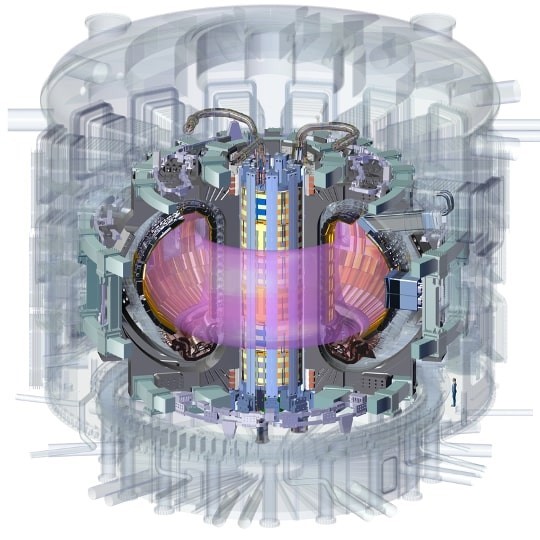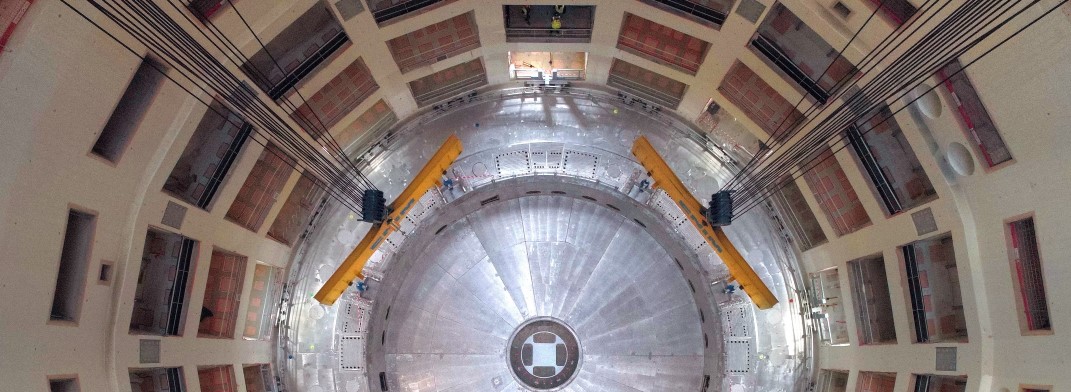Electricity from nuclear fusion: Experts open up new territory for fusion plant licensing
Nuclear fusion occurs naturally in the sun. On Earth, meanwhile, fusing two atoms involves a great deal of effort. The more research is done in this field, the sooner will concepts for commercial fusion plants appear on the horizon. A research project of GRS and the Karlsruhe Institute of Technology (KIT) is now looking at the regulatory framework for such plants.
For many countries, fusion represents a CO2-neutral and forward-looking form of energy production. Last summer, the largest international research project on fusion - ITER - launched the assembly of the fusion reactor and thus reached an important milestone. The aim of the ITER project is to demonstrate the scientific and technological feasibility of using fusion energy. DEMO, a fusion demonstration power plant, is being planned as a follow-up project for ITER; it is to generate electricity and pave the way for the utilisation of fusion energy.
In ITER and DEMO, heavy hydrogen (deuterium) is to fuse with superheavy hydrogen (tritium) to form helium, leaving one free neutron with each fusion. Since the reaction only starts at temperatures between 150 million and 300 million degrees Celsius, a plasma of deuterium and tritium is heated and confined inside a ring-shaped vacuum chamber by a strong magnetic field to prevent it from coming into contact with the wall. Long-lived fissile materials are not produced during nuclear fusion. However, tritium, a radioactive substance, is used. The free neutrons, which cannot be confined by the magnetic field, activate components of the reactor over time.
As fusion research progresses, the question of how future fusion reactors could be licensed and supervised becomes increasingly important. So far, no country has a regulatory framework for this.
Fusion power plants have specific safety requirements

A team of experts from GRS and KIT is currently investigating what a set of rules for future fusion plants could look like. "First of all, we have to look at which approaches for the licensing of fusion plants exist worldwide so far," says project leader Dr. Kay Nünighoff from GRS. "In a second step, we are interested in the specific safety aspects of fusion plants. Are the safety issues comparable to nuclear power plants and research reactors? If so, where are there similarities and where are differences? Where is ionising radiation generated, where are radioactive substances deposited that may be released in an accident? Which systems can fail and put plant safety as well as man and the environment at risk?“
On this basis, Nünighoff and his working group want to deduce where existing safety concepts need to be adopted or adapted and where additional safety requirements need to be elaborated. Currently, for example, there are hardly any regulatory requirements on how to deal with the large quantities of radioactive tritium in fusion plants. Since tritium rarely occurs in nature, it is incubated from lithium in the wall of the vacuum chamber - the so-called blanket. The same applies to risks associated with the spontaneous release of the energy stored in the superconducting magnets, which can cause damage to safety-relevant equipment.
While KIT contributes the scientific-technical experience with different systems of fusion plants, GRS provides its experience gained from the development of the German nuclear rules and regulations. With the Safety Requirements for Nuclear Power Plants, GRS - together with other experts - developed the basis of the nuclear rules and regulations on behalf of the Federal Ministry for the Environment, Nature Conservation and Nuclear Safety. GRS is also involved in the continual further development of the current nuclear rules and regulations of the International Atomic Energy Agency (IAEA) and supports other countries in the formulation and revision of their nuclear rules and regulations.
Fusion-specific set of rules as the outcome
One of the main outcomes of the project will be the proposal for a regulatory framework that covers the entire life cycle of a fusion plant – i.e. siting, construction, operation and decommissioning. At the same time, an action plan will be outlined to develop together with all stakeholders a European regulatory framework for fusion plants.
Finally, the proposals will be presented and discussed in a workshop with an international panel of experts and the European Commission and will then be published.
Find out more
- Explanation video: What happens during nuclear fission and nuclear fusion? (Youtube)
- GRS study: Investigation of the safety of nuclear fusion power plants with regard to nuclear incidents and accidents (in German)
- News: GRS prepares accident analyses for fusion reactor
- International fusion project ITER
- EU research consortium for fusion “Eurofusion“
Sven Dokter
GRS
Sven.Dokter@grs.de
